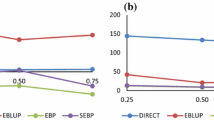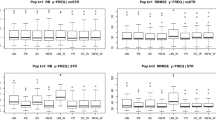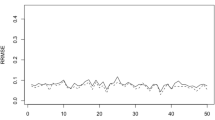Abstract
When surveys are not originally designed to produce estimates for small geographical areas, some of these domains can be poorly represented in the sample. In such cases, model-based small area estimators can be used to improve the accuracy of the estimates by borrowing information from other sub-populations. Frequently, in surveys related to agriculture, forestry or the environment, we are interested in analyzing continuous variables which are characterized by a strong spatial structure, a skewed distribution and a point mass at zero. In such cases, standard methods for small area estimation, which are based on linear mixed models, can be inefficient. The aim of this chapter is to discuss small area estimation models suggested in literature to handle zero-inflated, skewed, spatially structured data and to present them under the unified approach of generalized two-part random effects models.
Access this chapter
Tax calculation will be finalised at checkout
Purchases are for personal use only
Similar content being viewed by others
References
Albert, P., & Shen, J. (2005). Modelling longitudinal semicontinuous emesis volume data with serial correlation in an acupuncture clinical trial. Journal of the Royal Statistical Society Series C, 54, 707–720.
Battese, G., Harter, R., & Fuller, W. (1988). An error component model for prediction of county crop areas using survey and satellite data. Journal of the American Statistical Association, 83, 28–36.
Berg, E. and Chandra, H. (2012). Small area prediction for a unit level lognormal model. In Proceedings of the 2012 Federal Committee on Statistical Methodology Research Conference. Washington: DC, USA.
Berk, K. N., & Lachenbruch, P. A. (2002). Repeated measures with zeros. Statistical Methods in Medical Research, 11, 303–316.
Bocci, C., & Petrucci, A. (2016). Spatial information and geoadditive small area models. In M. Pratesi (Ed.), Analysis of poverty data by small area estimation (pp. 245–259). UK: Wiley.
Bocci, C., Petrucci, A., & Rocco, E. (2012). Small area methods for agricultural data, a two-part geoadditive model to estimate the agrarian region level means of the grapevines production in tuscany. Journal of the Indian Society of Agricultural Statistics, 66, 135–144.
Bocci, C., & Rocco, E. (2014). Estimates for geographical domains through geoadditive models in presence of incomplete geographical information. Statistical Methods and Applications, 23, 283–305.
Cantoni, E., Flemming, J. M., & Welsh, A. H. (2017). A random-effects hurdle model for predicting bycatch of endangered marine species. The Annals of Applied Statistics, 11, 2178–2199.
Chandra, H., & Chambers, R. (2011). Small area estimation under transformation to linearity. Survey Methodology, 37, 39–51.
Chandra, H., & Chambers, R. (2016). Small area estimation for semicontinuous data. Biometrical Journal, 58, 303–319.
Chandra, H., Salvati, N., & Chambers, R. (2018). Small area estimation under a spatially non-linear model. Computational Statistics and Data Analysis, 126, 19–38.
Chandra, H., & Sud, U. C. (2012). Small area estimation for zero-inflated data. Communications in Statistics - Simulation and Computation, 41, 632–643.
Cressie, N. (1993). Statistics for Spatial Data (revised ed.). New York: Wiley.
Datta, G. S., & Ghosh, M. (1991). Bayesian prediction in linear models: applications to small area estimation. The Annals of Statistics, 19, 1748–1770.
Dreassi, E., Petrucci, A., & Rocco, E. (2014). Small area estimation for semicontinuous skewed spatial data: An application to the grape wine production in Tuscany. Biometrical Journal, 56, 141–156.
Eilers, P. H. C., & Marx, B. D. (1996). Flexible smoothing with B-splines and penalties. Statistical Science, 11, 89–121.
Fahrmeir, L., & Lang, S. (2001). Bayesian inference for generalized additive mixed models based on markov random field priors. Journal of the Royal Statistical Society Series C, 50, 201–220.
Fay, R. E., & Herriot, R. A. (1979). Estimation of income from small places: An application of james-stein procedures to census data. Journal of the American Statistical Association, 74, 269–277.
Fotheringham, A. S., Brunsdon, C., & Charlton, M. E. (2002). Geographically weighted regression: The analysis of spatially varying Relationships. Chichester: Wiley.
Gosh, P., & Albert, P. S. (2009). A bayesian analysis for longitudinal semicontinuous data with an application to an acupuncture clinical trial. Computational Statistics and Data Analysis, 53, 699–706.
Hall, D. B. (2000). Zero-inflated poisson and binomial regression with random effects: A case study. Biometrics, 56, 1030–1039.
Hall, P., & Maiti, T. (2006). On parametric bootstrap methods for small area prediction. Journal Royal Statistical Society Series B, 68, 221–238.
Hastie, T., & Tibshirani, R. (1990). Generalized additive models. London: Chapman & Hall.
Jiang, J., Lahiri, P., & Wan, S. (2002). A unified Jackknife theory for empirical best prediction with M-estimation. Annals of Statistics, 30, 1782–1810.
Kammann, E. E., & Wand, M. P. (2003). Geoadditive models. Applied Statistics, 52, 1–18.
Karlberg, F. (2014). Small area estimation for skewed data in the presence of zeros. Statistics in Transition, 16, 541–562.
Kaufman, L., & Rousseeuw, P. J. (1990). Finding groups in data: An introduction to cluster analysis. New York: Wiley.
Krieg, S., Boonstra, H. J., & Smeets, M. (2016). Small-area estimation with zero-inflated data - a simulation study. Journal of Official Statistics, 32, 963–986.
Lambert, D. (1992). Zero-inflated Poisson regression with an application to defects in manufacturing. Technometrics, 34, 1–14.
Manteiga, G. W., Lombardìa, M. J., Molina, I., Morales, D., & Santamarìa, L. (2007). Estimation of the mean squared error of predictors of small area linear parameters under a logistic mixed model. Computational Statistics and Data Analysis, 51, 2720–2733.
Manteiga, G. W., Lombardìa, M. J., Molina, I., Morales, D., & Santamarìa, L. (2008). Bootstrap mean squared error of a small-area EBLUP. Journal of Statistical Computation and Simulation, 78, 443–462.
McCullagh, P., & Nelder, J. A. (1989). Generalized linear models (2nd ed.). London: Chapman and Hall.
Moura, F. A. S., Neves, A. F., & Silva, D. B. N. (2017). Small area models for skewed Brazilian business survey data. Journal of the Royal Statistical Society Series A, 180, 1039–1055.
Olsen, M. K., & Schafer, J. L. (2001). A two-part random-effects model for semicontinuous longitudinal data. Journal of the American Statistical Association, 96, 730–745.
Opsomer, J. D., Claeskens, G., Ranalli, M. G., Kauermann, G., & Breidt, F. J. (2008). Non-parametric small area estimation using penalized spline regression. Journal of the Royal Statistical Society Series B, 70, 265–286.
Pfeffermann, D., Terryn, B., & Moura, F. A. S. (2008). Small area estimation under a two-part random effects model with application to estimation of literacy in develo** countries. Survey Methodology, 34, 235–249.
Ridout, M., Hinde, J., & Demetrio, C. G. B. (2001). A score test for testing a zero-inflated Poisson regression model against zero-inflated negative binomial alternative. Biometrics, 57, 219–223.
Ruppert, D., Wand, M. P., & Carroll, R. J. (2003). Semiparametric regression. Cambridge: Cambridge University Press.
Tooze, J. A., Grunwald, G. K., & Jones, R. H. (2002). Analysis of repeated measures data with clum** at zero. Statistical Methods in Medical Research, 11, 341–355.
Wand, M. P. (2003). Smoothing and mixed models. Computational Statistics, 18, 223–249.
Author information
Authors and Affiliations
Corresponding author
Editor information
Editors and Affiliations
Rights and permissions
Copyright information
© 2020 Springer Nature Singapore Pte Ltd.
About this chapter
Cite this chapter
Bocci, C., Dreassi, E., Petrucci, A., Rocco, E. (2020). Small Area Estimation for Skewed Semicontinuous Spatially Structured Responses. In: Chandra, G., Nautiyal, R., Chandra, H. (eds) Statistical Methods and Applications in Forestry and Environmental Sciences. Forum for Interdisciplinary Mathematics. Springer, Singapore. https://doi.org/10.1007/978-981-15-1476-0_15
Download citation
DOI: https://doi.org/10.1007/978-981-15-1476-0_15
Published:
Publisher Name: Springer, Singapore
Print ISBN: 978-981-15-1475-3
Online ISBN: 978-981-15-1476-0
eBook Packages: Mathematics and StatisticsMathematics and Statistics (R0)




